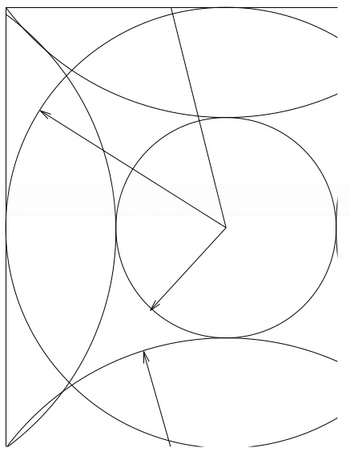Wrap-around errors
Wrap-around errors arise if the Fast Fourier transformation (FFT) meshes are not sufficiently large. It can be shown that no errors exist if the FFT meshes contain all [math]\displaystyle{ \mathbf{G} }[/math] vectors up to [math]\displaystyle{ 2 G_{\rm cut} }[/math].

It can be shown that the charge density contains components up to [math]\displaystyle{ 2 G_{\mathrm{cut}} }[/math], where [math]\displaystyle{ 2 G_{\mathrm{cut}} }[/math] is the "longest" plane wave in the basis set:
The wavefunction is defined as
- [math]\displaystyle{ | \phi_{n\mathbf{k}} \rangle = \sum_\mathbf{G} C_{\mathbf{G}n\mathbf{k}} | \mathbf{k}+\mathbf{G}\rangle, }[/math]
and in real space it is given by
- [math]\displaystyle{ \langle \mathbf{r}| \phi_{n\mathbf{k}} \rangle = \sum_\mathbf{G} \langle \mathbf{r}| \mathbf{k}+\mathbf{G}\rangle \langle \mathbf{k}+\mathbf{G}|\phi_{n\mathbf{k}} \rangle = \frac{1}{\Omega^{1/2}} \sum_\mathbf{G} e^{i(\mathbf{k}+\mathbf{G})\mathbf{r}} C_{\mathbf{G}n\mathbf{k}}. }[/math]
Using FFTs one can define
- [math]\displaystyle{ C_{\mathbf{r}n\mathbf{k}}= \sum_{\mathbf{G}} C_{\mathbf{G}n\mathbf{k}} e^{i\mathbf{G} \mathbf{r}} \qquad \qquad \qquad C_{\mathbf{G}n\mathbf{k}}= \frac{1}{N_{\mathrm{FFT}}} \sum_{\mathbf{r}} C_{\mathbf{r}n\mathbf{k}} e^{-i\mathbf{G} \mathbf{r}}. }[/math]
Therefore the wavefunction can be written in real space as
- [math]\displaystyle{ \langle\mathbf{r}| \phi_{n\mathbf{k}} \rangle = \phi_{n\mathbf{k}}(r) = \frac{1}{\Omega^{1/2}} C_{\mathbf{r}n\mathbf{k}} e^{i\mathbf{k}\mathbf{r}}. }[/math]
The charge density is simply given by
- [math]\displaystyle{ \rho^{\mathrm{ps}}_{\mathbf{r}} \equiv \langle \mathbf{r} |\rho^{\mathrm{ps}} | \mathbf{r} \rangle = \sum_\mathbf{k} w_{\mathbf{k}} \sum_n f_{n\mathbf{k}} \phi_{n\mathbf{k}}(r) \phi^{*}_{n\mathbf{k}}(r) , }[/math]
and in the reciprocal mesh it can be written as
- [math]\displaystyle{ \rho^{\mathrm{ps}}_\mathbf{G} \equiv \frac{1}{\Omega} \int \langle\mathbf{r} | \rho^{\mathrm{ps}}| \mathbf{r}\rangle e^{-i \mathbf{G}\mathbf{r}}\, d \mathbf{r} \to \frac{1}{N_{\mathrm{FFT}}} \sum_{\mathbf{r}} \rho^{\mathrm{ps}}_{\mathbf{r}} e^{-i \mathbf{G}\mathbf{r}}. }[/math]
Using the above equations for [math]\displaystyle{ \rho^{\mathrm{ps}}_{\mathbf{r}} }[/math] and [math]\displaystyle{ C_{\mathbf{r}n\mathbf{k}} }[/math] it is very easy to show that [math]\displaystyle{ \rho^{\mathrm{ps}}_{\mathbf{r}} }[/math] contains Fourier-components up to [math]\displaystyle{ 2 G_{\mathrm{cut}} }[/math].
Generally it can be shown that a the convolution [math]\displaystyle{ f_r=f^1_r f^2_r }[/math] of two functions [math]\displaystyle{ f^1_r }[/math] with Fourier-components up to [math]\displaystyle{ G_1 }[/math] and [math]\displaystyle{ f^2_r }[/math] with Fourier-components up to [math]\displaystyle{ G_2 }[/math] contains Fourier-components up to [math]\displaystyle{ G_1+G_2 }[/math].
The property of the convolution comes once again into play, when the action of the Hamiltonian onto a wavefunction is calculated. The action of the local-potential is given by
- [math]\displaystyle{ a_{\mathbf{r}} = V_{\mathbf{r}} C_{\mathbf{r}n\mathbf{k}}. }[/math]
Only the components [math]\displaystyle{ a_{\mathbf{G}} }[/math] with [math]\displaystyle{ |\mathbf{G}| \lt G_{\mathrm{cut}} }[/math] are taken into account (see section ALGO: [math]\displaystyle{ a_{\mathbf{G}} }[/math] is added to the wavefunction during the iterative refinement of the wavefunctions [math]\displaystyle{ C_{\mathbf{G}n\mathbf{k}} }[/math], and [math]\displaystyle{ C_{\mathbf{G}n\mathbf{k}} }[/math] contains only components up to [math]\displaystyle{ G_{\mathrm{cut}} }[/math]). From the previous theorem we see that [math]\displaystyle{ a_{\mathbf{r}} }[/math] contains components up to [math]\displaystyle{ 3 G_{\mathrm{cut}} }[/math] ([math]\displaystyle{ V_{\mathbf{r}} }[/math] contains components up to [math]\displaystyle{ 2 G_{\mathrm{cut}} }[/math]).
If the FFT mesh contains all components up to [math]\displaystyle{ 2 G_{\mathrm cut} }[/math] the resulting wrap-around error is once again 0. This can be easily seen in Fig. 1. Here we see that the small sphere contains all plane waves included in the basis set [math]\displaystyle{ G\lt G_{\mathrm{cut}} }[/math]. The charge density contains components up to [math]\displaystyle{ 2 G_{\mathrm{cut}} }[/math] (second sphere), and the acceleration [math]\displaystyle{ a }[/math] components up to [math]\displaystyle{ 3 G_{\mathrm{cut}} }[/math], which are reflected in (third sphere) because of the finite size of the FFT mesh. Nevertheless the components [math]\displaystyle{ a_{\mathbf{G}} }[/math] with [math]\displaystyle{ | \mathbf{G}| \lt G_{\mathrm{cut}} }[/math] are correct i.e. the small sphere does not intersect with the third large sphere}
